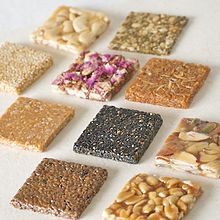Chikki
 Peanut chikki | |
| Alternative names | Kadalai (Kadale) Mittai,(Git) Gud Badam, Palli Patti, Kappalandi Muthai, Thua Tat, Amrutam |
|---|---|
| Type | Brittle |
| Course | Snack |
| Place of origin | India |
| Region or state | India,Pakistan,Bangladesh |
| Main ingredients | Peanuts,jaggery |
Chikkiis a traditionalIndian sweet(brittle) generally made fromnutsandjaggery/sugar.[1]There are several different varieties of chikki in addition to the most common groundnut (peanut) chikki. Each variety of chikki is named after the ingredients used, which include puffed or roastedBengal gram,sesame, puffed rice, beaten rice, or khobra (desiccated coconut), and other nuts such as almonds, cashews and pistachios.
| This article is part of the series on |
| Indian cuisine |
|---|
 |
In regions ofNorth India,especiallyBiharandUttar Pradesh,this sweet is calledlayiya patti.InSindhprovince of Pakistan, it is calledlayeeorlai.In north Indian states, it is also known asgajakormaroonda.InBangladesh,West Bengaland other Bengali-speaking regions, it is known asgur badam.InMaharashtrait is called asChikki.In the South Indian states ofTelanganaandAndhra Pradesh,it is calledpalli patti (పల్లీ పట్టీ).InKeralait is called Kappalandi muthai. InTamil Naduit is called kadalai mittai. InKarnatakait's calledKadale Mittai.Similar dishes are also very popular inBrazil,where it is known aspé-de-moleque,inParaguay,where it is calledka'i ladrillo,and inThailand,where it is calledthua tat.[citation needed]
Ingredients
[edit]
Chikkis are made using a combination of ingredients. Special chikkis are made out ofcashews,almonds,pistachios,and alsosesame seed.Though jaggery is the usual sweetener material, sugar is sometimes used as the base. It is a very popular sweet item in both rural and urban South Asia. In the South Indian state ofTamil Nadu,preparation often takes place with a larger proportion of nuts to jaggery. In several states, chikkis in both square and round forms are available.
Preparation
[edit]The preparation of chikkis consists of first preparing the hot jaggery syrup with a minimum of water, adding nuts to the syrup to coat them (with the syrup) and then transferring the nuts to a wooden mould, then rolling them to a thickness of about 6–8 mm using a wooden roller, then placing into a steel plate for cooling, cutting into slabs, and packing. In homes, smaller quantities are hand rolled with wooden rollers.
Most popular chikkis are sourced from the Indian towns ofBhujinGujarat;KovilpattiinTamil Nadu;Madurai,Palakkad,Central Travancore,Kannur,CherthalainKerala,Lonavala,Matheran,Mahabaleshwar,Panchgani,andKarjatinMaharashtra.[2]In Mumbai, a variety of chikki is made usingrajgira(amaranth).[3]

See also
[edit]- Tilsakri (Tilpatti/Tilpapdi),[4]a similar candy with sesame seeds
- Kovilpatti
- Lonavala chikki
- Peanut brittle,a similar candy with a lower proportion of nuts
- Gozinaki
- Yeot-gangjeong
- List of peanut dishes
- Tameletjie
- Alegría (Mexican candy)
- Pé-de-moleque
References
[edit]- ^Chitrodia, Rucha Biju."A low-cal twist to sweet sensations".The Times of India.Archived fromthe originalon 23 October 2012.Retrieved19 August2012.
- ^Vaid, Molshree."Chikki on a Sticky Wicket".The Times of India.Retrieved19 August2012.
- ^Ved, Sonal (15 February 2021)."Everything you need to know about rajgira, the lesser-known Indian superfood".Vogue India.Condé Nast.Retrieved20 November2022.
- ^Dasa, Syamasundara (1965–1975)."Hindi sabdasagara".dsal.uchicago.edu.Retrieved16 April2023.
